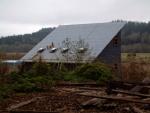I called for a preliminary inspection before I glued the whole thing together. Matt was nice enough to come out even though it's not routine to inspect unfinished work. He told me my "wet vent" plan wasn't going to fly even though my piping is all well oversized.
It is one of the advantages of a small house. Using the largest possible piping doesn't cost much when the run is only 7'.
I redid the venting, but I didn't like the result after I glued it up. 4" pipe turns out to be tricky because when it is dry-fit it will often not fully seat in the fitting. Even so, it's really hard to take apart. However, once glued, the unset glue acts like a lubricant letting the parts fully engage. Unfortunately this tight fit means that the dimensions shrink. It's easy to lose a half inch or more once the glue goes in. This caused me no end of problems.
Likewise getting all the angles right. It's not so easy in 3D. Understanding that a 45 degree angle pipe needs another 45 degrees to change direction to 90 degrees isn't hard. But what if that 45 degrees is dropping out of the cieling pointing NNE mating to a pipe running east with a 45 degree bend to the south but canted 45 degrees up? The best answer I found is to buy a whole lot of 22, 45, and 90 degree bends and return the ones you don't use.

My first DWV
The photo shows the completed and entire DWV for the house. The bath was deliberately backed up against the kitchen sink to minimize plumbing and to make the hot water run as short as possible.
I did have to redo the water closet (WC a.k.a. toilet, crapper, shitter, can, head, etc.) and sink portion for the reasons cited above and because I wasn't satisfied that it was an elegant enough solution.
Next hot and cold water.
I did have to redo the water closet (WC a.k.a. toilet, crapper, shitter, can, head, etc.) and sink portion for the reasons cited above and because I wasn't satisfied that it was an elegant enough solution.
Next hot and cold water.





